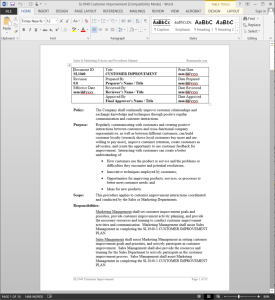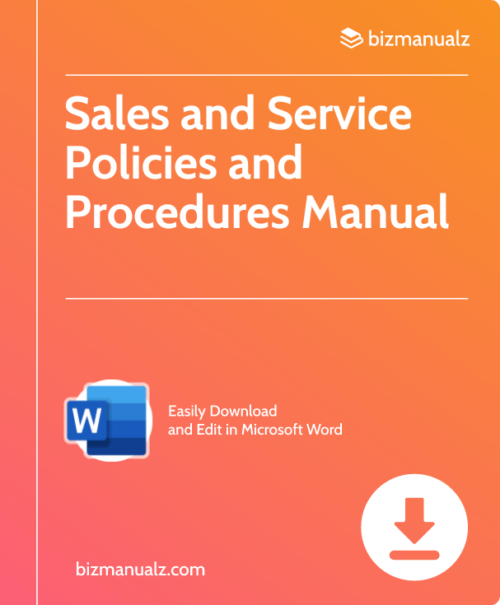 Customer Improvement Procedure
Customer Improvement Procedure
The Customer Improvement Procedure facilitates customer relationship improvement. The customer quality procedure also aids in building your customer loyalty, improving customer retention, creating customers as advocates, and creating the opportunity to use customer feedback for improvement by creating positive interactions with customers and cross-functional company representatives.
This procedure applies to customer improvement interactions coordinated and conducted by the sales or marketing departments. (10 pages, 1536 words)
Interacting with customers can create a better understanding of:
- How customers use the product or service and the problems or difficulties they encounter and potential resolutions;
- Innovative techniques employed by customers;
- Opportunities for improving products, services, or processes to better meet customer needs; and
- Ideas for new products.
Customer Improvement Responsibilities:
Marketing Management should set customer improvement goals and priorities, provide customer improvement activity planning, and provide the necessary resources and training to conduct customer improvement activities and communication. Marketing Management should assist Sales Management in completing the SL1040-1 CUSTOMER IMPROVEMENT PLAN.
Sales Management should assist Marketing Management in setting customer improvement goals and priorities, and actively participate in customer improvement. Sales Management should also provide the resources and training for the Sales Department to actively participate in the customer improvement process. Sales Management should assist Marketing Management in completing the SL1040-1 CUSTOMER IMPROVEMENT PLAN.
Top Management should oversee all customer improvement efforts and guide long term goal and efforts, and oversee collection and reporting of customer improvement data and reports.
Sales Staff , Marketing Staff, and all Company employees involved in Customer Improvement should listen to and record important customer feedback (negative and positive) and enter feedback information into the SL1050-1 CUSTOMER FEEDBACK FORM.
Customer Improvement Definition:
Customer Improvement – The process of planning and carrying out varying interactions with customers in order to improve customer product implementation and customer relations, improve products and services, and improve internal processes.
 Customer Improvement Procedure Activities
Customer Improvement Procedure Activities
- Customer Improvement Plan
- Customer Improvement Actions
- Measuring Customer Improvement
- Enhancing Customer Improvement
Customer Improvement Procedure Forms
Listen to Your Customers and Change Accordingly
Voice of the Customer (VOC) is quality-speak for taking action to reflect what your customers want in your products and communications. The key is you must listen to your customers! Let’s compare in an example with Company A and Company B.
COMPANY A
Company A’s corporate customers thought they were buying the time of skilled installers and customer service troubleshooters on demand. In an effort to be different from its competitors who also sold skilled labor hours, Company A offered additional benefits that its skilled workers brought to the table such as cross-training and process improvement.
At first, “differentiating” the marketing message seemed like a good idea. Essentially, Company A was offering higher levels of service that it said would help customers improve operations and save money. But when interviewed, customers didn’t seem to get it. They resisted the idea that contract hires were in a position to influence substantial changes in business practices within their companies. Instead customers said they would rather pay less and get just the services they valued.
But customers did say that Company A provided rapid availability of highly skilled, highly specialized technicians. And they would even pay a little more for what they perceived as consistent well-managed delivery of the right skills at the right time.
But Company A was unwilling to change its story. Rather it persisted in a story that was out of sync with the voice of their customer. Company A failed to separate its aspirations for the future with the current perceptions of its paying customers. But you can only ignore the voice of the customer for a time.
When the recession hit a few months later and corporations sought to cut expenses, services they did not immediately value were hard to justify, and easy targets. As a result, Company A lost several customers and a double-digit percent of its revenue.
COMPANY B
 Now, onto Company B. When Company B got its foot in the door of some big-time potential accounts, it heard what customers said, and reflected those perceptions of value in its product offering. Company B took action to sell what customers wanted right away, and then set out to increase the value of their services over time as their customers came to trust them.
Now, onto Company B. When Company B got its foot in the door of some big-time potential accounts, it heard what customers said, and reflected those perceptions of value in its product offering. Company B took action to sell what customers wanted right away, and then set out to increase the value of their services over time as their customers came to trust them.
Company B also listened to the language that potential clients used to talk about their problems, and then employed that language when describing their services. Company B took to heart what it learned in half a dozen customer interviews (truly listened to the customers) to focus its product development and marketing message on recognized benefits.
As the selling proposition shifted to incorporate the voice of the customer, potential clients quickly recognized the value of the service that Company B offered. They could get exactly what they wanted and needed from Company B, and they were willing to pay for it. More and more frequently, when Company B got their foot in the door, they settled in for a nice long stay.
When interviewing our client’s customers, we listen for what they value. We listen for what they are paying for today. Then we help customers focus their product development resources on what they can sell today. With increased sales, we can help our clients build organizations that deliver value consistently, thus building trust with their customers. Trust is a solid platform on which to deliver increasingly valuable and unique services, thus achieving our strategy. Without first building trust, strategy is simply an aspiration with no concrete steps.
Truly hearing the voice of the customer means reflecting back to them in your own language what customers truly value. Adjusting your products to provide that value demonstrates true customer quality.





















Reviews
There are no reviews yet.